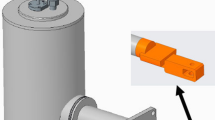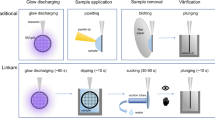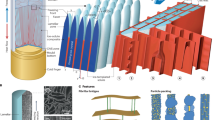Abstract
FREEZING is an important technique in the preservation of the morphology of biological materials for electron microscopic examination. Methods relying on freeze-fracturing, sometimes followed by etching, have been developed and have led to advances in the interpretation of biological ultrastructure1. Other, related applications of freezing are for the preservation of biological activity2 and the preparation of biological specimens for microanalysis of low molecular weight components3. The freezing of cells and tissues can, like all other methods of fixation, give rise to artefacts, although probably to a lesser extent than the more traditional methods. The most important factors governing the quality of biological freezing include the size distribution of the ice crystals, the extent of supercooling and the possibility of osmotic dehydration and shrinkage of cells. Very high cooling rates are considered essential to minimise the deleterious effects of ice crystals, and to overcome excessive osmotic shrinkage of cells by extracellular ice formation, the use of cryoprotective agents is common. It is believed that an effective, penetrating cryoprotectant must diffuse into the cell without, at the same time, interfering with its morphology. Glycerol and dimethylsulphoxide fulfil these conditions and are widely used as cryoprotectants, although it is known that they can interfere with the physiological functions of some cells4.
This is a preview of subscription content, access via your institution
Access options
Subscribe to this journal
Receive 51 print issues and online access
$199.00 per year
only $3.90 per issue
Buy this article
- Purchase on Springer Link
- Instant access to full article PDF
Prices may be subject to local taxes which are calculated during checkout
Similar content being viewed by others
References
Freeze Etching Techniques and Applications (edit. by Benedetti. E. L., and Favard, P.), (Société Francaise de Microscopic Electronique, Paris, 1973).
Farrant, J., Proc. R. Soc, (in the press).
Echlin, P., J. Microscopie Biol. cell., 22, 215–226 (1975).
Moor, H., Phil. Trans. R. Soc., B 261, 121–131 (1971).
Rasmussen, D. H., Macaulay, M. N., and MacKenzie, A. P., Cryobiology, 12, 328–339 (1975).
MacKenzie, A. P., and Rasmussen, D. H., in Water Structure at the Water– Polymer Interface (edit. by Jellinek, H. H. G.), 146–172 (Plenum, New York, 1972).
Author information
Authors and Affiliations
Rights and permissions
About this article
Cite this article
FRANKS, F., SKAER, H. Aqueous glasses as matrices in freeze-fracture electron microscopy. Nature 262, 323–325 (1976). https://doi.org/10.1038/262323a0
Received:
Accepted:
Published:
Issue Date:
DOI: https://doi.org/10.1038/262323a0
This article is cited by
-
Structural elements in adenovirus cores. Studies by means of freeze-fracturing and ultrathin sectioning
Archives of Virology (1978)
Comments
By submitting a comment you agree to abide by our Terms and Community Guidelines. If you find something abusive or that does not comply with our terms or guidelines please flag it as inappropriate.



